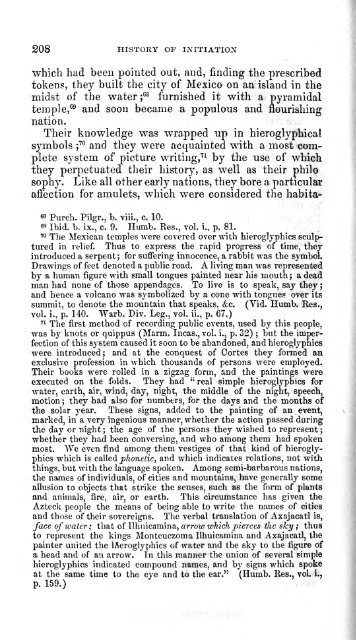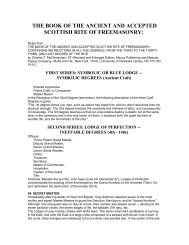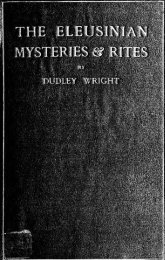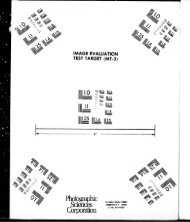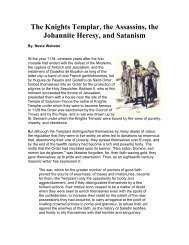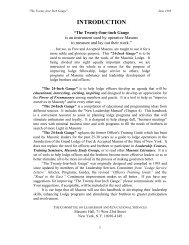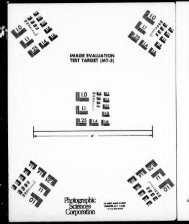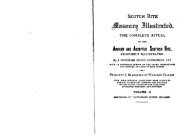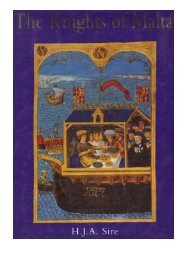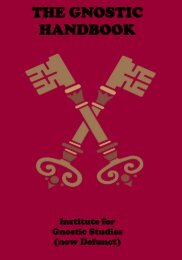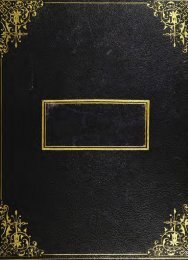The History of Initiation - The Masonic Trowel
The History of Initiation - The Masonic Trowel
The History of Initiation - The Masonic Trowel
Create successful ePaper yourself
Turn your PDF publications into a flip-book with our unique Google optimized e-Paper software.
208 HISTORY OF INITIATION<br />
which had been pointed out, and, finding the prescribed<br />
tokens, they built the city <strong>of</strong> Mexico on an island in the<br />
GS<br />
midst <strong>of</strong> the water furnished ;<br />
it with a pyramidal<br />
temple, 69 and soon became a populous and flourishing<br />
nation.<br />
<strong>The</strong>ir knowledge was wrapped up in hieroglyphical<br />
symbols ;<br />
70 and they were acquainted with a most complete<br />
system <strong>of</strong> picture writing, 71 the "use <strong>of</strong> which<br />
they perpetuated their history, as well as their philo<br />
sophy. Like all other early nations, they bore a particular<br />
affection for amulets, which were considered the habita-<br />
68 Purch. Pilgr., b. viii.. c. 10.<br />
by<br />
69 Ibid. b. ix., c. 9. Humb. Res., vol. i., p. 81.<br />
70 <strong>The</strong> Mexican temples were covered over with hieroglyphics sculptured<br />
in relief. Thus to express the rapid progress <strong>of</strong> time, they<br />
introduced a serpent; for suffering innocence, a rabbit was the sj'mbol.<br />
Drawings <strong>of</strong> feet denoted a public road. A living man was represented<br />
by a human figure with small tongues painted near his mouth a dead<br />
;<br />
man had none <strong>of</strong> those appendages. To live is to speak, say they;<br />
and hence a volcano was symbolized by a cone with tongues over its<br />
summit, to denote the mountain that speaks, &c. (Vid. Humb. Res.,<br />
vol. i., p. 140. Warb. Div. Leg., vol. ii., p. 67.)<br />
71 <strong>The</strong> first method <strong>of</strong> recording public events, used by this people,<br />
was by knots or quippus (Marm. Incas., vol. i., p. 32) ; but the imperfection<br />
<strong>of</strong> this system caused it soon to be abandoned, and hieroglyphics<br />
were introduced; and at the conquest <strong>of</strong> Cortes they formed an<br />
exclusive pr<strong>of</strong>ession in which thousands <strong>of</strong> persons were employed.<br />
<strong>The</strong>ir books were rolled in a zigzag form, and the paintings were<br />
executed on the folds. <strong>The</strong>y had ''real simple hieroglyphics for<br />
water, earth, air, wind, day, night, the middle <strong>of</strong> the night, speech,<br />
motion ; they had also for numbers, for the days and the months <strong>of</strong><br />
the solar year. <strong>The</strong>se signs, added to the painting <strong>of</strong> an event,<br />
marked, in a very ingenious manner, whether the action passed during<br />
the day or night ; the age <strong>of</strong> the persons they wished to represent ;<br />
whether they had been conversing, and who among them had spoken<br />
most. We even find among them vestiges <strong>of</strong> that kind <strong>of</strong> hieroglyphics<br />
which is called phonetic, and which indicates relations, not with<br />
things, but with the language spoken. Among semi-barbarous nations,<br />
the names <strong>of</strong> individuals, <strong>of</strong> cities and mountains, have generally some<br />
allusion to objects that strike the senses, such as the form <strong>of</strong> plants<br />
and animals, fire, air, or earth. This circumstance has given the<br />
Azteck people the means <strong>of</strong> being able to write the names <strong>of</strong> cities<br />
and those <strong>of</strong> their sovereigns. <strong>The</strong> verbal translation <strong>of</strong> Axajacatl is,<br />
face <strong>of</strong> water; that <strong>of</strong> Ilhuicamina, arrow which pierces the sky; thus<br />
to represent the kings Monteuczoma Ilhuicamina and Axajacatl, the<br />
painter united the hieroglyphics <strong>of</strong> water and the sky to the figure <strong>of</strong><br />
a head and <strong>of</strong> an arrow. In this manner the union <strong>of</strong> several simple<br />
hieroglyphics indicated compound names, and by signs which spoke<br />
at the same time to the eye and to the ear." (Humb. Res., vol. i.,<br />
p. 159.)


